Psychology: Problem Analysis and Experimental Study
VerifiedAdded on 2021/12/14
|6
|1049
|276
Report
AI Summary
This report presents a comprehensive analysis of a psychology assignment, focusing on factor analysis, regression analysis, and experimental design. The factor analysis identifies key variables and their communalities, with reliability assessed using Cronbach's alpha. The regression analysis examines the influence of mindfulness, narcissism, and conscientiousness on resilience, considering assumptions like multicollinearity and normality. The experimental analysis explores the impact of mindfulness training across different educational levels. Statistical tests, including Mauchly’s Test of Sphericity and pairwise comparisons, are employed to interpret the relationships between variables and determine the significance of findings. The report concludes with insights into the interaction effects and combined roles of various psychological factors in influencing individual resilience. The student has contributed this assignment to Desklib, a platform providing AI-based study tools and resources.
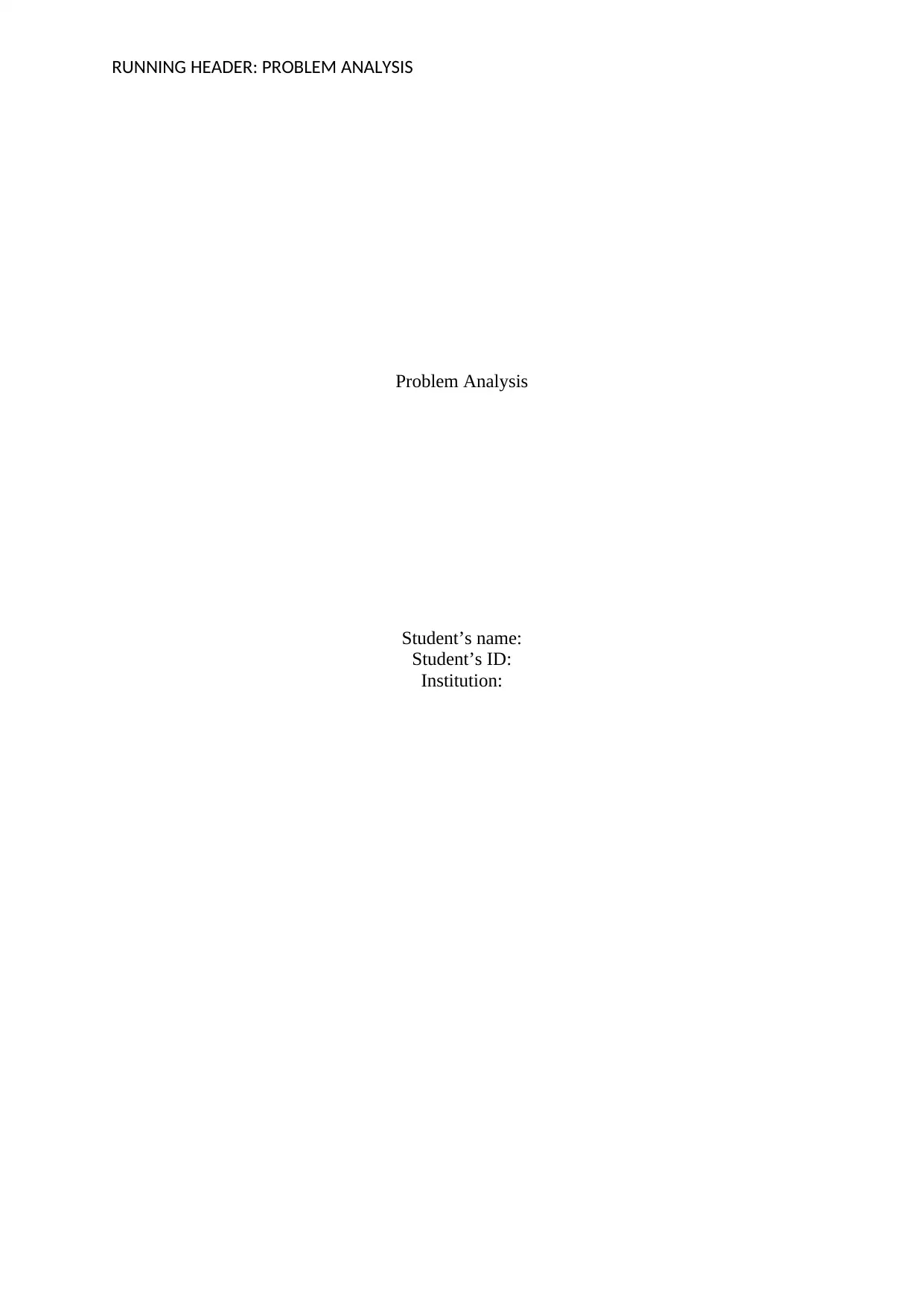
RUNNING HEADER: PROBLEM ANALYSIS
Problem Analysis
Student’s name:
Student’s ID:
Institution:
Problem Analysis
Student’s name:
Student’s ID:
Institution:
Paraphrase This Document
Need a fresh take? Get an instant paraphrase of this document with our AI Paraphraser
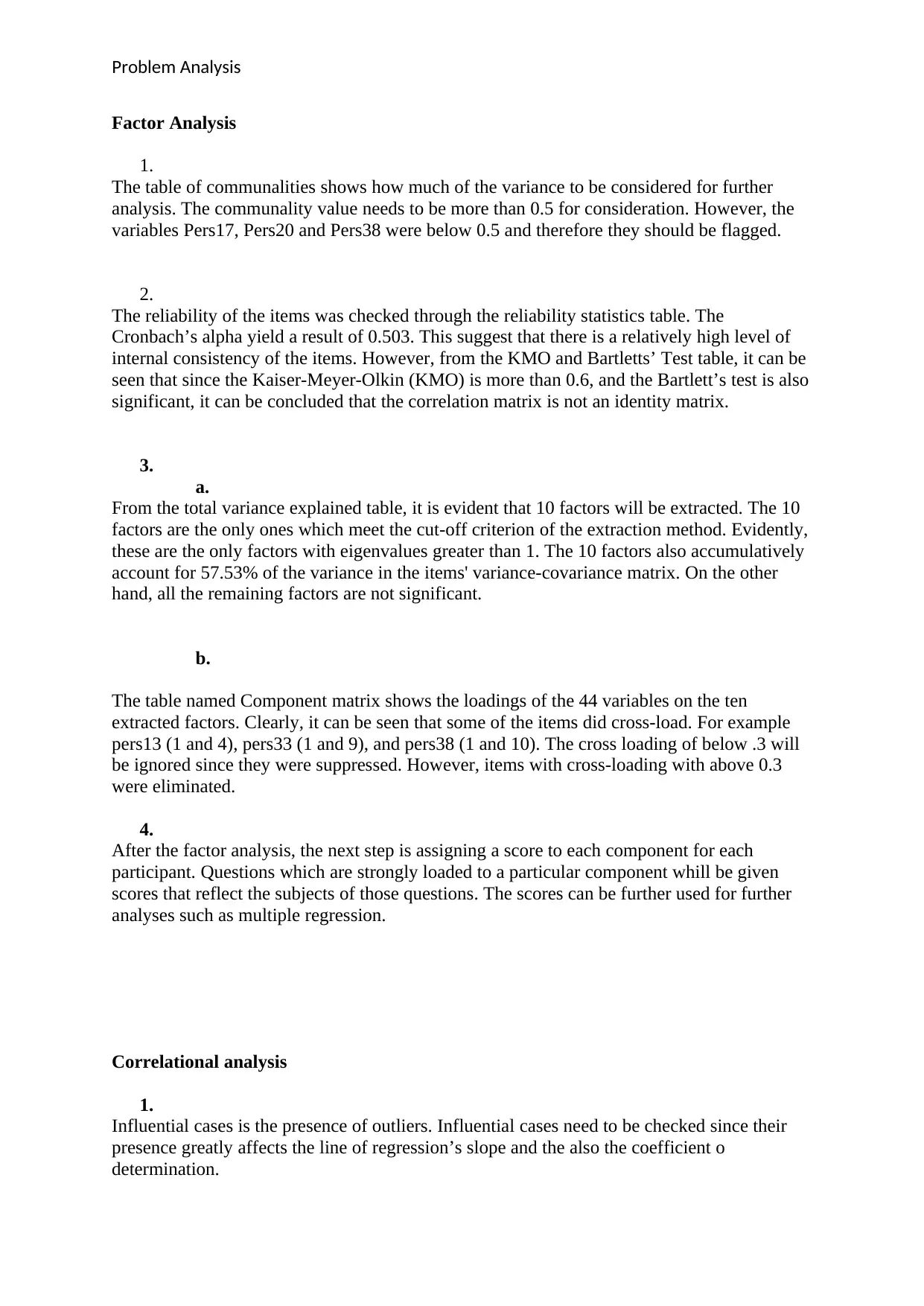
Problem Analysis
Factor Analysis
1.
The table of communalities shows how much of the variance to be considered for further
analysis. The communality value needs to be more than 0.5 for consideration. However, the
variables Pers17, Pers20 and Pers38 were below 0.5 and therefore they should be flagged.
2.
The reliability of the items was checked through the reliability statistics table. The
Cronbach’s alpha yield a result of 0.503. This suggest that there is a relatively high level of
internal consistency of the items. However, from the KMO and Bartletts’ Test table, it can be
seen that since the Kaiser-Meyer-Olkin (KMO) is more than 0.6, and the Bartlett’s test is also
significant, it can be concluded that the correlation matrix is not an identity matrix.
3.
a.
From the total variance explained table, it is evident that 10 factors will be extracted. The 10
factors are the only ones which meet the cut-off criterion of the extraction method. Evidently,
these are the only factors with eigenvalues greater than 1. The 10 factors also accumulatively
account for 57.53% of the variance in the items' variance-covariance matrix. On the other
hand, all the remaining factors are not significant.
b.
The table named Component matrix shows the loadings of the 44 variables on the ten
extracted factors. Clearly, it can be seen that some of the items did cross-load. For example
pers13 (1 and 4), pers33 (1 and 9), and pers38 (1 and 10). The cross loading of below .3 will
be ignored since they were suppressed. However, items with cross-loading with above 0.3
were eliminated.
4.
After the factor analysis, the next step is assigning a score to each component for each
participant. Questions which are strongly loaded to a particular component whill be given
scores that reflect the subjects of those questions. The scores can be further used for further
analyses such as multiple regression.
Correlational analysis
1.
Influential cases is the presence of outliers. Influential cases need to be checked since their
presence greatly affects the line of regression’s slope and the also the coefficient o
determination.
Factor Analysis
1.
The table of communalities shows how much of the variance to be considered for further
analysis. The communality value needs to be more than 0.5 for consideration. However, the
variables Pers17, Pers20 and Pers38 were below 0.5 and therefore they should be flagged.
2.
The reliability of the items was checked through the reliability statistics table. The
Cronbach’s alpha yield a result of 0.503. This suggest that there is a relatively high level of
internal consistency of the items. However, from the KMO and Bartletts’ Test table, it can be
seen that since the Kaiser-Meyer-Olkin (KMO) is more than 0.6, and the Bartlett’s test is also
significant, it can be concluded that the correlation matrix is not an identity matrix.
3.
a.
From the total variance explained table, it is evident that 10 factors will be extracted. The 10
factors are the only ones which meet the cut-off criterion of the extraction method. Evidently,
these are the only factors with eigenvalues greater than 1. The 10 factors also accumulatively
account for 57.53% of the variance in the items' variance-covariance matrix. On the other
hand, all the remaining factors are not significant.
b.
The table named Component matrix shows the loadings of the 44 variables on the ten
extracted factors. Clearly, it can be seen that some of the items did cross-load. For example
pers13 (1 and 4), pers33 (1 and 9), and pers38 (1 and 10). The cross loading of below .3 will
be ignored since they were suppressed. However, items with cross-loading with above 0.3
were eliminated.
4.
After the factor analysis, the next step is assigning a score to each component for each
participant. Questions which are strongly loaded to a particular component whill be given
scores that reflect the subjects of those questions. The scores can be further used for further
analyses such as multiple regression.
Correlational analysis
1.
Influential cases is the presence of outliers. Influential cases need to be checked since their
presence greatly affects the line of regression’s slope and the also the coefficient o
determination.
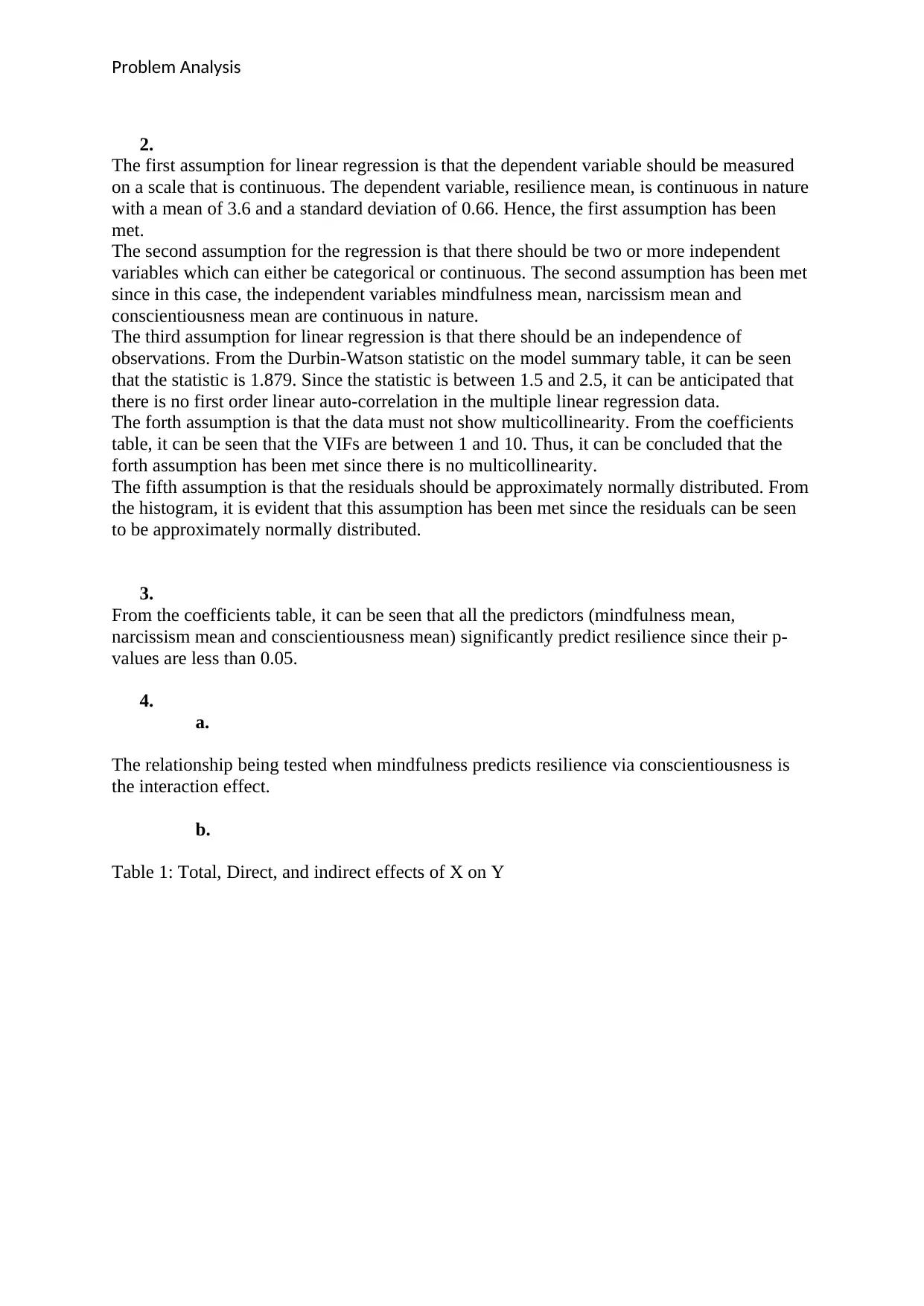
Problem Analysis
2.
The first assumption for linear regression is that the dependent variable should be measured
on a scale that is continuous. The dependent variable, resilience mean, is continuous in nature
with a mean of 3.6 and a standard deviation of 0.66. Hence, the first assumption has been
met.
The second assumption for the regression is that there should be two or more independent
variables which can either be categorical or continuous. The second assumption has been met
since in this case, the independent variables mindfulness mean, narcissism mean and
conscientiousness mean are continuous in nature.
The third assumption for linear regression is that there should be an independence of
observations. From the Durbin-Watson statistic on the model summary table, it can be seen
that the statistic is 1.879. Since the statistic is between 1.5 and 2.5, it can be anticipated that
there is no first order linear auto-correlation in the multiple linear regression data.
The forth assumption is that the data must not show multicollinearity. From the coefficients
table, it can be seen that the VIFs are between 1 and 10. Thus, it can be concluded that the
forth assumption has been met since there is no multicollinearity.
The fifth assumption is that the residuals should be approximately normally distributed. From
the histogram, it is evident that this assumption has been met since the residuals can be seen
to be approximately normally distributed.
3.
From the coefficients table, it can be seen that all the predictors (mindfulness mean,
narcissism mean and conscientiousness mean) significantly predict resilience since their p-
values are less than 0.05.
4.
a.
The relationship being tested when mindfulness predicts resilience via conscientiousness is
the interaction effect.
b.
Table 1: Total, Direct, and indirect effects of X on Y
2.
The first assumption for linear regression is that the dependent variable should be measured
on a scale that is continuous. The dependent variable, resilience mean, is continuous in nature
with a mean of 3.6 and a standard deviation of 0.66. Hence, the first assumption has been
met.
The second assumption for the regression is that there should be two or more independent
variables which can either be categorical or continuous. The second assumption has been met
since in this case, the independent variables mindfulness mean, narcissism mean and
conscientiousness mean are continuous in nature.
The third assumption for linear regression is that there should be an independence of
observations. From the Durbin-Watson statistic on the model summary table, it can be seen
that the statistic is 1.879. Since the statistic is between 1.5 and 2.5, it can be anticipated that
there is no first order linear auto-correlation in the multiple linear regression data.
The forth assumption is that the data must not show multicollinearity. From the coefficients
table, it can be seen that the VIFs are between 1 and 10. Thus, it can be concluded that the
forth assumption has been met since there is no multicollinearity.
The fifth assumption is that the residuals should be approximately normally distributed. From
the histogram, it is evident that this assumption has been met since the residuals can be seen
to be approximately normally distributed.
3.
From the coefficients table, it can be seen that all the predictors (mindfulness mean,
narcissism mean and conscientiousness mean) significantly predict resilience since their p-
values are less than 0.05.
4.
a.
The relationship being tested when mindfulness predicts resilience via conscientiousness is
the interaction effect.
b.
Table 1: Total, Direct, and indirect effects of X on Y
⊘ This is a preview!⊘
Do you want full access?
Subscribe today to unlock all pages.

Trusted by 1+ million students worldwide
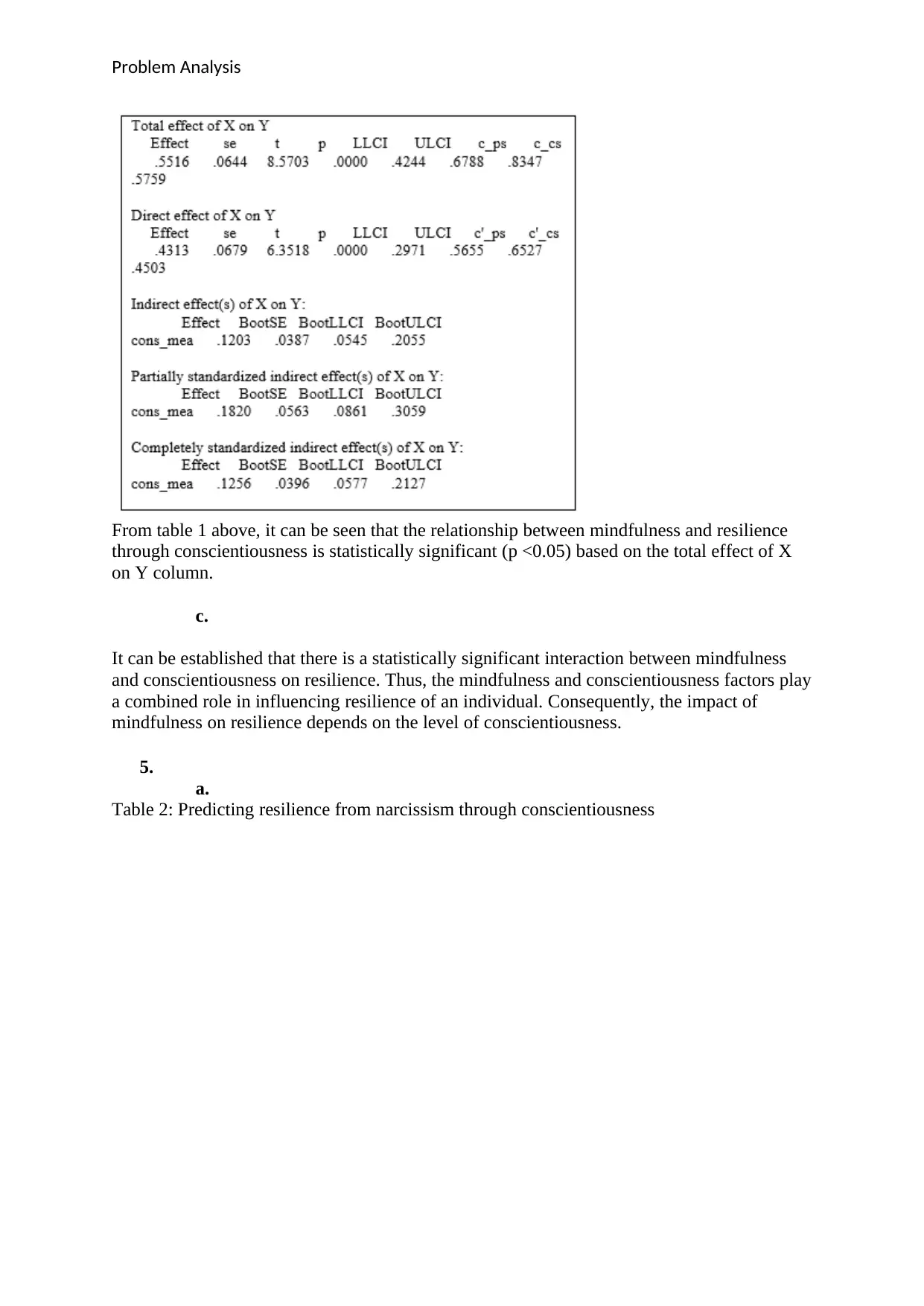
Problem Analysis
From table 1 above, it can be seen that the relationship between mindfulness and resilience
through conscientiousness is statistically significant (p <0.05) based on the total effect of X
on Y column.
c.
It can be established that there is a statistically significant interaction between mindfulness
and conscientiousness on resilience. Thus, the mindfulness and conscientiousness factors play
a combined role in influencing resilience of an individual. Consequently, the impact of
mindfulness on resilience depends on the level of conscientiousness.
5.
a.
Table 2: Predicting resilience from narcissism through conscientiousness
From table 1 above, it can be seen that the relationship between mindfulness and resilience
through conscientiousness is statistically significant (p <0.05) based on the total effect of X
on Y column.
c.
It can be established that there is a statistically significant interaction between mindfulness
and conscientiousness on resilience. Thus, the mindfulness and conscientiousness factors play
a combined role in influencing resilience of an individual. Consequently, the impact of
mindfulness on resilience depends on the level of conscientiousness.
5.
a.
Table 2: Predicting resilience from narcissism through conscientiousness
Paraphrase This Document
Need a fresh take? Get an instant paraphrase of this document with our AI Paraphraser
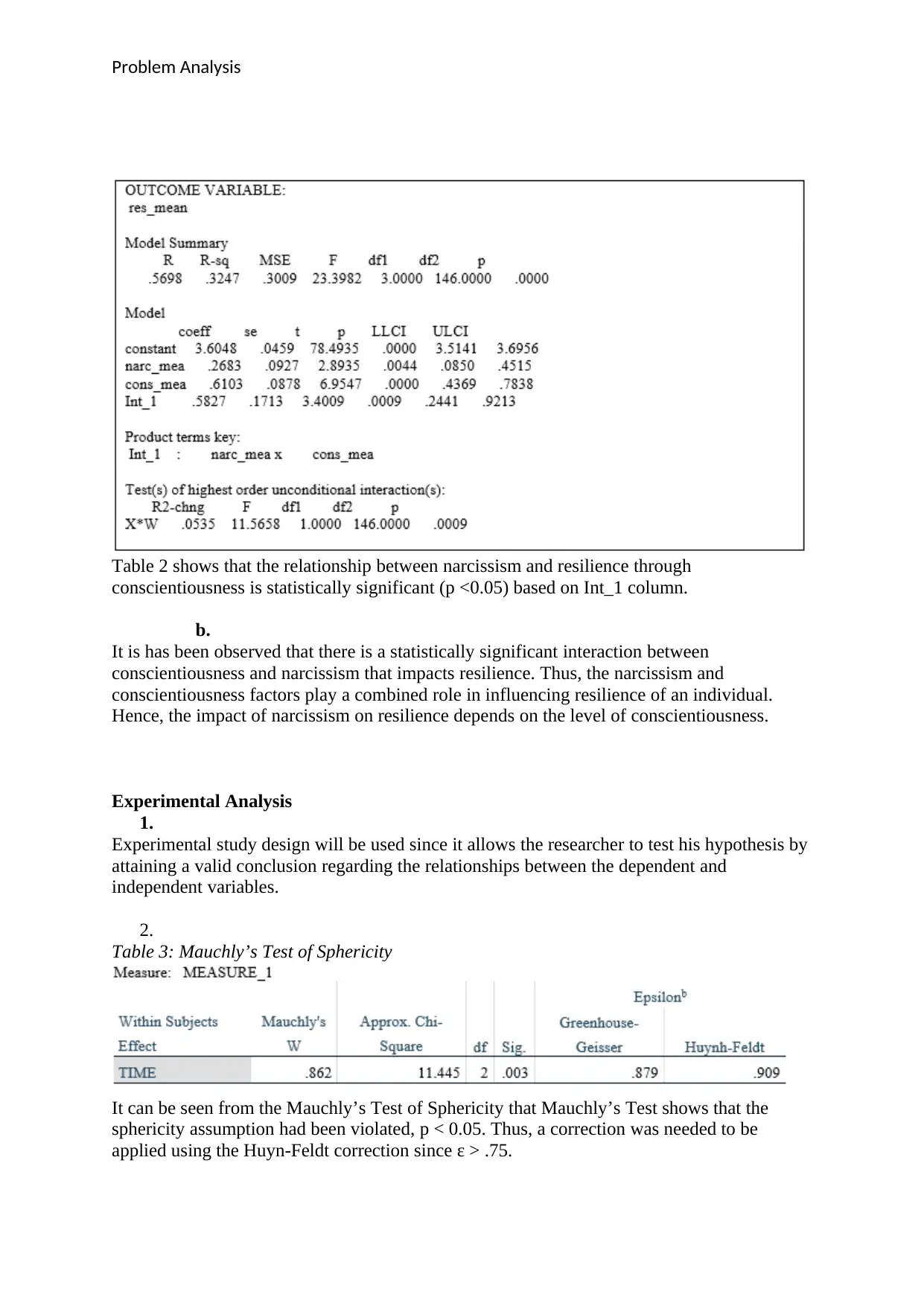
Problem Analysis
Table 2 shows that the relationship between narcissism and resilience through
conscientiousness is statistically significant (p <0.05) based on Int_1 column.
b.
It is has been observed that there is a statistically significant interaction between
conscientiousness and narcissism that impacts resilience. Thus, the narcissism and
conscientiousness factors play a combined role in influencing resilience of an individual.
Hence, the impact of narcissism on resilience depends on the level of conscientiousness.
Experimental Analysis
1.
Experimental study design will be used since it allows the researcher to test his hypothesis by
attaining a valid conclusion regarding the relationships between the dependent and
independent variables.
2.
Table 3: Mauchly’s Test of Sphericity
It can be seen from the Mauchly’s Test of Sphericity that Mauchly’s Test shows that the
sphericity assumption had been violated, p < 0.05. Thus, a correction was needed to be
applied using the Huyn-Feldt correction since ε > .75.
Table 2 shows that the relationship between narcissism and resilience through
conscientiousness is statistically significant (p <0.05) based on Int_1 column.
b.
It is has been observed that there is a statistically significant interaction between
conscientiousness and narcissism that impacts resilience. Thus, the narcissism and
conscientiousness factors play a combined role in influencing resilience of an individual.
Hence, the impact of narcissism on resilience depends on the level of conscientiousness.
Experimental Analysis
1.
Experimental study design will be used since it allows the researcher to test his hypothesis by
attaining a valid conclusion regarding the relationships between the dependent and
independent variables.
2.
Table 3: Mauchly’s Test of Sphericity
It can be seen from the Mauchly’s Test of Sphericity that Mauchly’s Test shows that the
sphericity assumption had been violated, p < 0.05. Thus, a correction was needed to be
applied using the Huyn-Feldt correction since ε > .75.
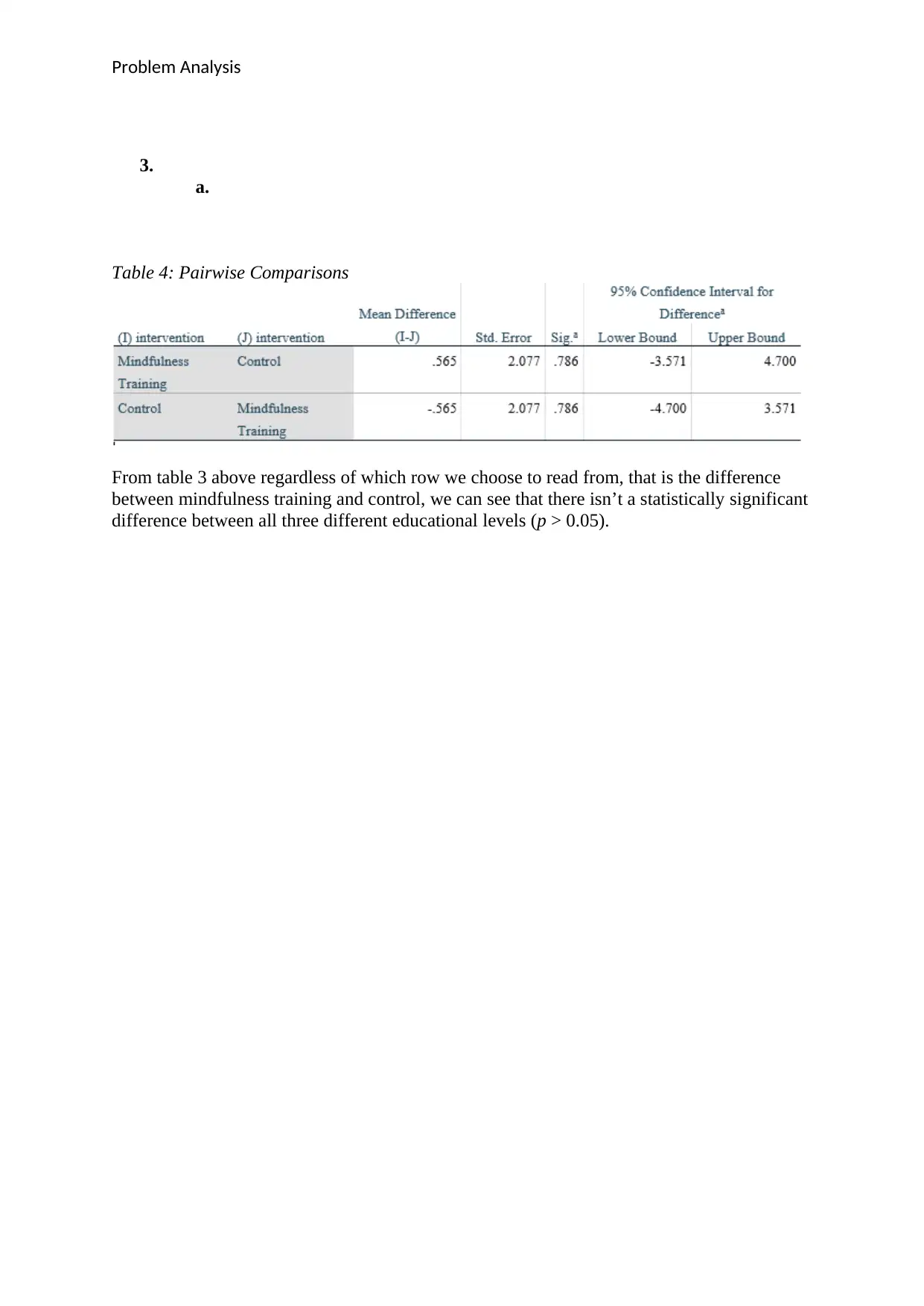
Problem Analysis
3.
a.
Table 4: Pairwise Comparisons
From table 3 above regardless of which row we choose to read from, that is the difference
between mindfulness training and control, we can see that there isn’t a statistically significant
difference between all three different educational levels (p > 0.05).
3.
a.
Table 4: Pairwise Comparisons
From table 3 above regardless of which row we choose to read from, that is the difference
between mindfulness training and control, we can see that there isn’t a statistically significant
difference between all three different educational levels (p > 0.05).
⊘ This is a preview!⊘
Do you want full access?
Subscribe today to unlock all pages.

Trusted by 1+ million students worldwide
1 out of 6
Related Documents
Your All-in-One AI-Powered Toolkit for Academic Success.
+13062052269
info@desklib.com
Available 24*7 on WhatsApp / Email
![[object Object]](/_next/static/media/star-bottom.7253800d.svg)
Unlock your academic potential
Copyright © 2020–2025 A2Z Services. All Rights Reserved. Developed and managed by ZUCOL.





